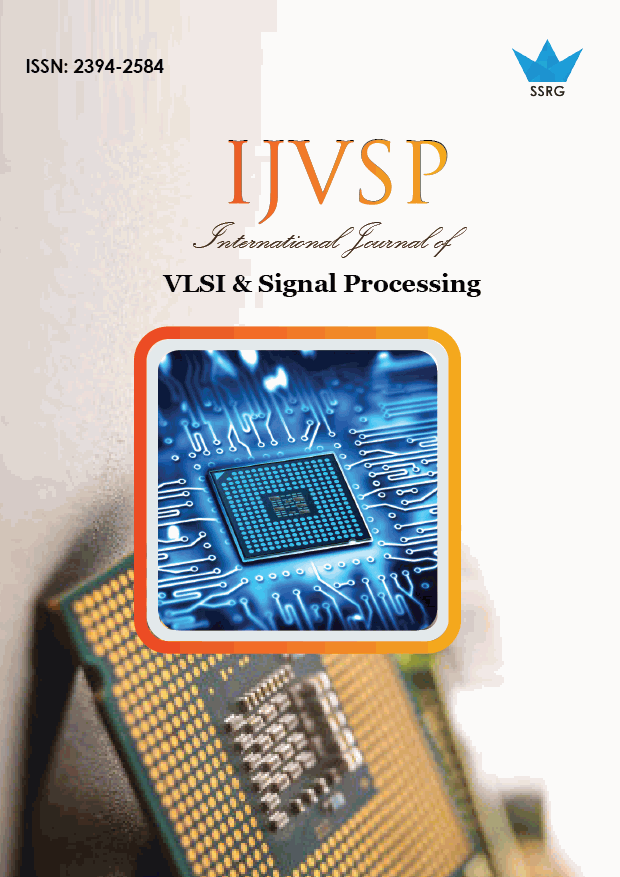Analysis and Optimization of Power Consumption and Area of Domino Full Adder

| International Journal of VLSI & Signal Processing |
| © 2015 by SSRG - IJVSP Journal |
| Volume 2 Issue 2 |
| Year of Publication : 2015 |
| Authors : B. Krishna Naga Deepthi and Dr.M.V.Subramanyam |
How to Cite?
B. Krishna Naga Deepthi and Dr.M.V.Subramanyam, "Analysis and Optimization of Power Consumption and Area of Domino Full Adder," SSRG International Journal of VLSI & Signal Processing, vol. 2, no. 2, pp. 14-19, 2015. Crossref, https://doi.org/10.14445/23942584/IJVSP-V2I2P104
Abstract:
In this paper we analyse different domino logic full adder circuits by considering area, power consumption and number of transistors as the three main parameters which plays an important role in digital design. We proposed a hybrid logic based domino full adder circuit which provides better performance in the above mentioned three parameters than the existing circuits. The two important applications of full adder 1-bit Alu and 2-bit Comparator of the proposed circuit is also presented. All the circuits are designed and simulated using DSCH and MICROWIND tool.
Keywords:
Full adder, Domino logic, Area, power consumption, Alu, Comparator.
References:
[1] J. M. Rabaey, A. Chandrakasan, B. Nikolic,“Digital Integrated Circuits- A Design Perspective”, 2nd Prentice Hall, Englewood Cliffs, NJ, 2002.
[2] J. Uyemura, “CMOS Logic Circuit Design”, ISBN 0-7923-8452-0, Kluwer, 1999
[3] http://en.wikipedia.org/wiki/Adder_(electronics)..
[4] D. Wang, M. Yang, W. Cheng, X. Guan, Z. Zhu, and Y. Yang, “Novel low power full adder cells in 180nm CMOS technology”, IEEE Conference on Industrial Electronicsand Applications (ICIEA ‟09), May 2009, pp.430–433.
[5] S. Wairya, R. K. Nagaria, and S. Tiwari, “Performance Analysis of High Speed Hybrid CMOS Full Adder Circuits for Low Voltage VLSI Design”, VLSI Design, 2012, pp. 1-18.
[6] S. Kang and Y. Leblebici, “CMOS Digital Integrated Circuits, Analysis and Design”, 2003, Tata McGraw-Hill, New York, NY, USA.
[7] Wang. J, Gong. N, Hou. L, Peng. X, Geng. S and Wu. W, “Low power and highperformance dynamic CMOS XOR/XNOR gate design”, Microelectronics Engineering,2011, Vol.88, pp.2781-2784.
[8] P. K. Verma, S. K. Singh, A. Kumar and S. Singh “Design and Analysis of Logic Gates Using Static and Domino Logic Technique”, International Journal of Scientific & Technology Research, June 2012, Vol. 1, No. 5, pp. 122-125.
[9] S. Jia, S. Lyu, Q. Meng, F. Wu and H. Xu, “A New Low-Power CMOS Dynamic Logic Circuit”, IEEE conference on EDDSSC, 2013,Hong Kong.
[10] K.S. Yeo, K. Roy, “Low- Voltage, Low- Power VLSI Subsystems”.
[11] H. F. Dadgour and K. Banerjee, “A Novel Variation-Tolerant Keeper Architecture for High-Performance Low-Power Wide Fan-In Dynamic OR Gates”, IEEE Trans. on VLSI Systems, Nov. 2010, Vol. 18, No. 11, pp. 1567-1577.
[12] H.T. Bui, Y. Wang and Y. Jiang, ―Design and analysis of low-power 10-transister full adders using XOR-XNOR gates,‖ IEEE Trans. Circuits Syst. II, Analog Digit. Signal Process, Vol. 49, no. 1, pp. 25- 30, Jan. 2002.
[13] N. Wesley and K. Eshraghian, “Principles of CMOS VLSI Design,” 2nd ED., AddisonWesley
[14] Analysis of Several 2:1 Multiplexer Circuits at 90nm and 45nm Technologies, Ila Gupta, Neha Arora, Prof. B.P. Singh, International Journal of Scientific and Research Publications, Volume 2, Issue 2, February 2012
[15] Sumeer Goel, Mohammed A. Elgamel, Magdy A. Bayoumi, Yasser Hanafy, (2006) ―Design Methodologies for High- Performance Noise-Tolerant XOR-XNOR Circuits,‖ IEEE Transactions on Circuits and Systems- I, Vol. 53, No. 4, pp. 867-878.

 10.14445/23942584/IJVSP-V2I2P104
10.14445/23942584/IJVSP-V2I2P104